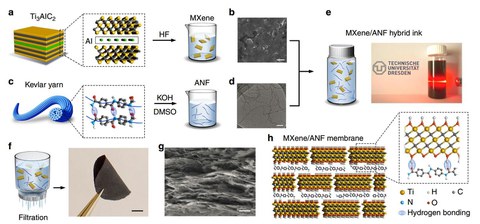Jul 02, 2019
Mechanically strong MXene/Kevlar nanofiber composite membranes as high-performance nanofluidic osmotic power generators
Two-dimensional nanofluidic channels are emerging candidates for capturing osmotic energy from salinity gradients. However, present two-dimensional nanofluidic architectures are generally constructed by simple stacking of pristine nanosheets with insufficient charge densities and exhibit low-efficiency transport dynamics, consequently resulting in undesirable power densities of less than 1 W m-2.
The researchers from Technische Universität Dresden (Chair for Molecular Functional Materials) demonstrate a high-performance nanofluidic osmotic power generator by hybridizing 2D MXene nanosheets with 1D Kevlar nanofibers (ANFs). The ANF can serve as an intercalating agent that will enlarge the interlayer channel and prevent the restacking of adjacent MXene nanosheets. More importantly, the ANFs are negatively charged in solution and their entanglement in confined channel can create a negatively charged space charge zone. By mixing artificial river water and sea water, the output power density can achieve ~3.7 W m-2, which is the highest value ever reported in both 1D and 2D nanofluidic channel membrane systems. Replacing the artificial water with natural water resource can contribute to a substantially high power density about 4.1 W m-2, much closer to the commercialization benchmark. Additionally, benefitting from the introduction of ultrastrong structural unit ANF, the composite membrane also exhibits excellent mechanical strength and good stability, showing great application prospects. This work highlights the promise in the coupling of surface charge and space charge in nanoconfinement for energy conversion driven by chemical potential gradients.
This work was supported by the Alexander von Humboldt Foundation, the European Union’s Horizon 2020 research and innovation program under grant agreement No. 785219, the European Science Foundation (ESF), and the Coordination Networks: Building Blocks for Functional Systems (SPP1928, COORNET). The authors acknowledge the Dresden Center for Nanoanalysis (DCN) at TU Dresden.
Reference:
Zhen Zhang, Sheng Yang, Panpan Zhang, Jian Zhang, Guangbo Chen, and Xinliang Feng*, Mechanically strong MXene/Kevlar nanofiber composite membranes as high-performance nanofluidic osmotic power generators. Nat. Commun. 2019, DOI: 10.1038/s41467-019-10885-8.

